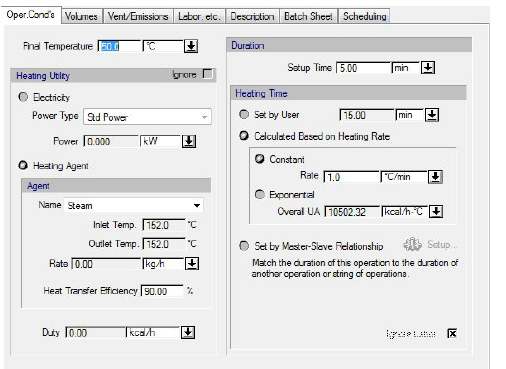

The following table shows a brief description of the variables appearing in this tab. The table also displays their default values and their generally acceptable range:
|
Variable |
Default Value |
Range |
|
|
||
|
○ Final Temperature (oC) |
50.0 |
Positive |
|
○ Ignore Heating Utility |
No |
Yes/No |
|
○ Power Type |
<Std Power> |
Any Power Type |
|
● Power (kW) |
0.0 |
Positive |
|
○ Heating Agent Name |
<Steam> |
Any Heating Agent |
|
● Inlet Temp. (oC) |
152.0 |
Positive |
|
● Outlet Temp. (oC) |
152.0 |
Positive |
|
● Rate (kg/h) |
0.0 |
Positive |
|
● Duty (kcal/h) |
0.0 |
Positive |
|
○ Heat Transfer Efficiency (%) |
90.0 |
[0,100) |
|
○ Setup Time (min) |
5.0 |
Positive |
|
◙ Heating Time (min) |
15.0 |
Positive |
|
◙ Heating Rate (oC/min) |
1.0 |
Positive |
|
◙ Overall UA (kcal/h-oC) |
10502.32 |
Positive |
|
○ Ignore Labor? |
Yes |
Yes/No |
Symbol Key: ○ User-specified value (always input); ● Calculated value (always output); ◙ Sometimes input, sometimes output
The following list describes the available specification choices in this tab; for more details on how these are implemented, see Batch Heating: Modeling Calculations.
•If the Heating Utility is ignored...
No energy balances are done.
•Duration options...
You can set the process time (heating time), or have the process time calculated based on heating rate, or match the duration of this operation to the duration of another operation by introducing a master-slave relationship between the two operations. There are two options for specifying the heating rate: you can either specify a constant heating rate or an exponential heating rate (specify the overall UA). If you introduce a master-slave relationship, the program will match the setup time, the process time and the turnaround time of this operation (the ‘slave’) with the corresponding times of the reference operation (the ‘master’ operation). For more details on how to setup a master-slave relationship, see The Scheduling Tab.